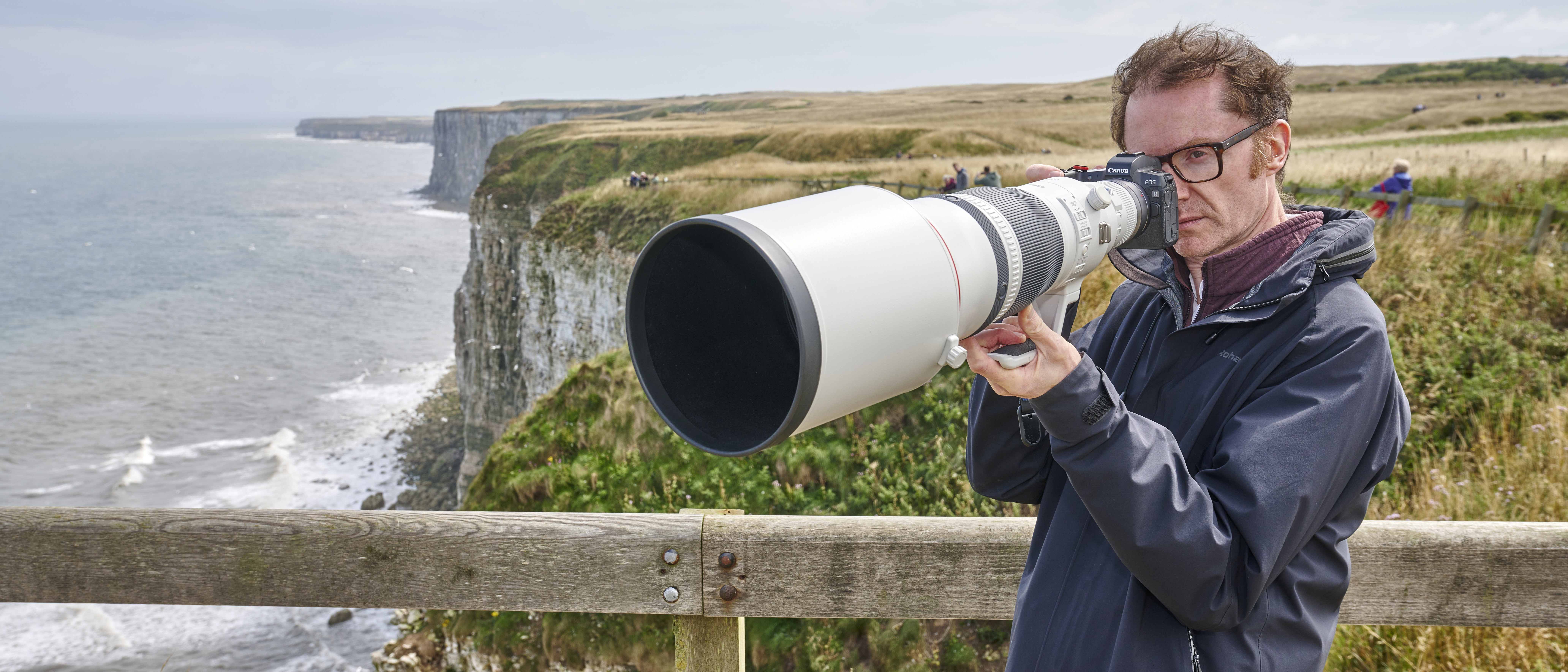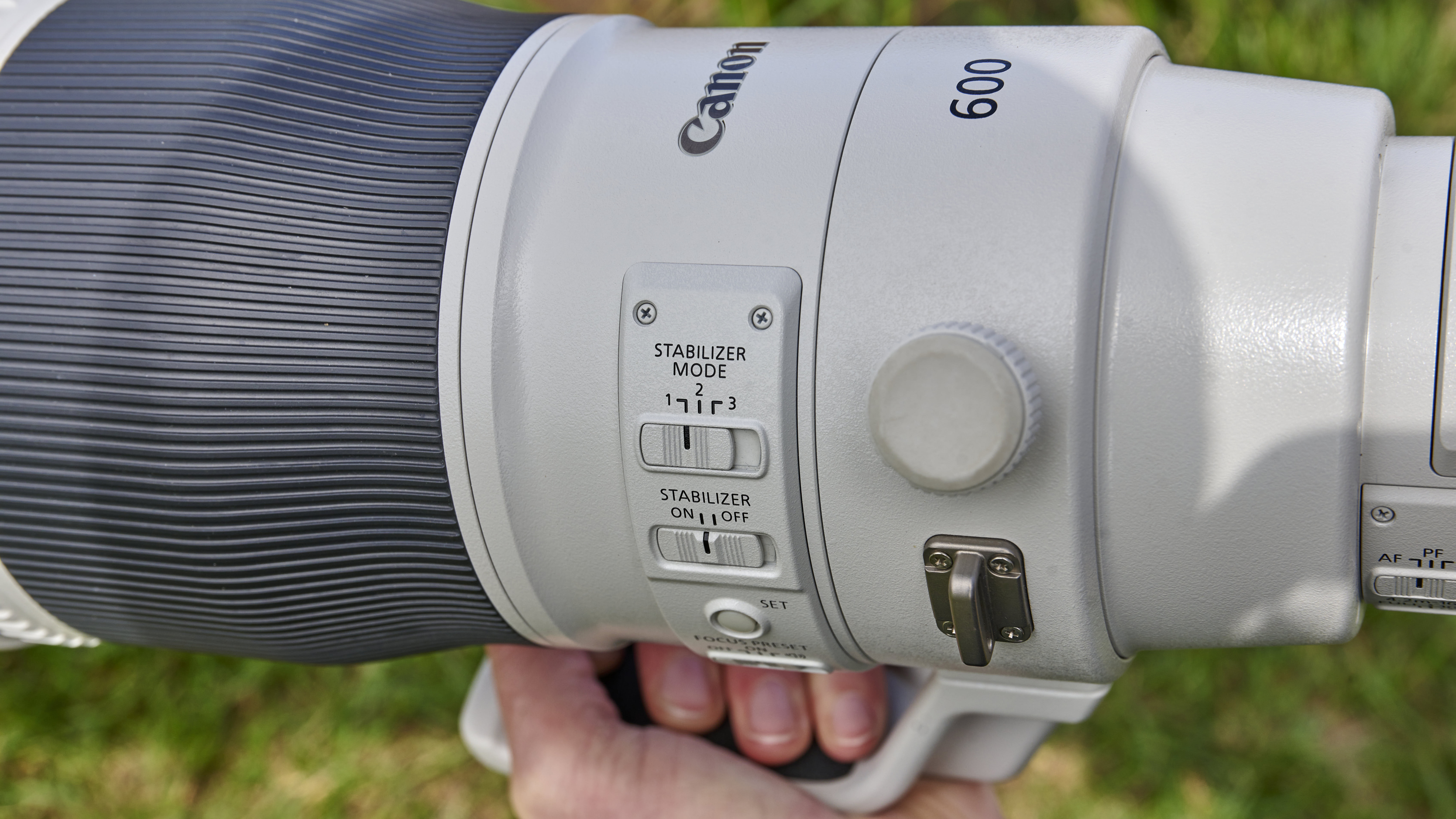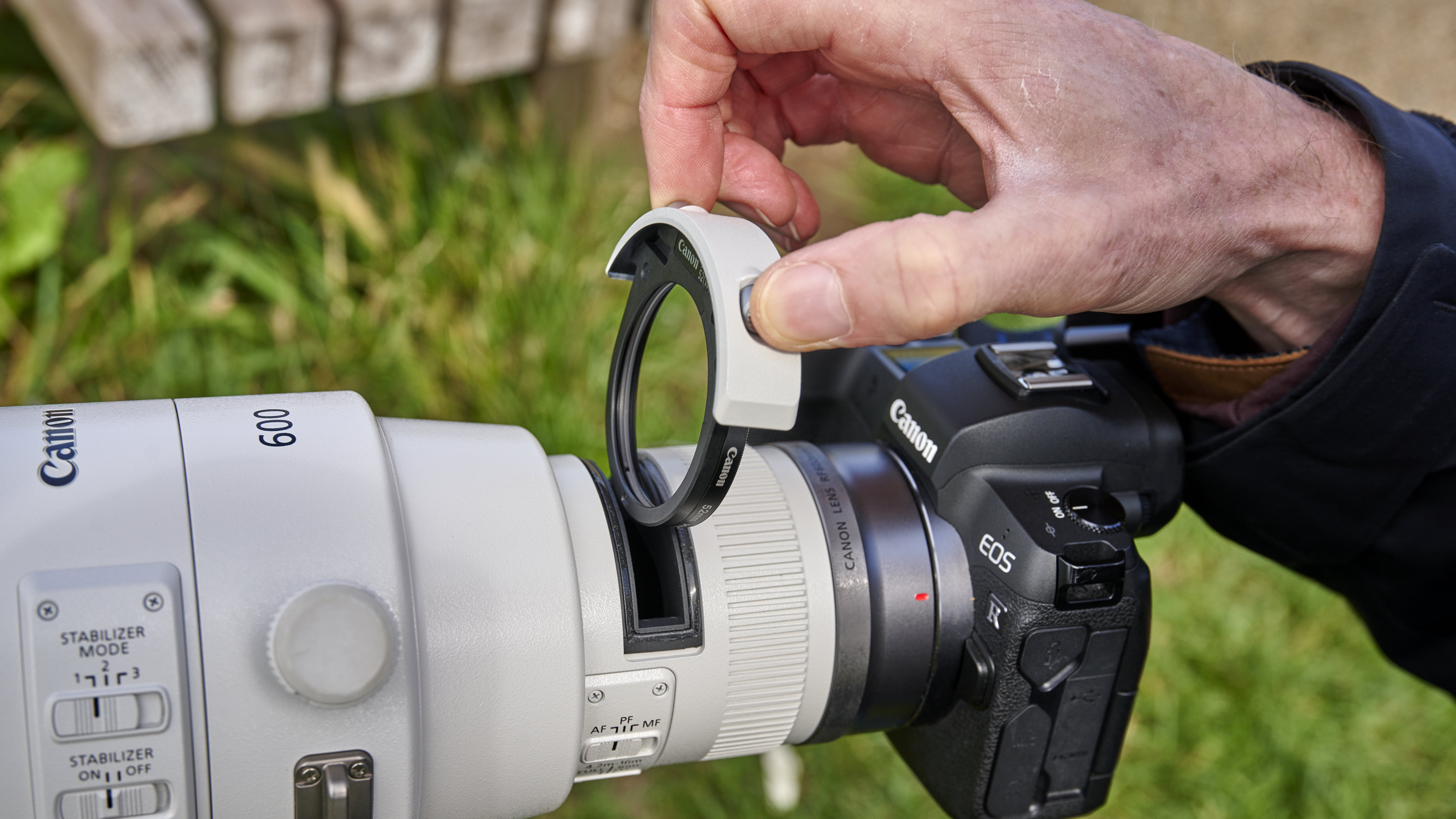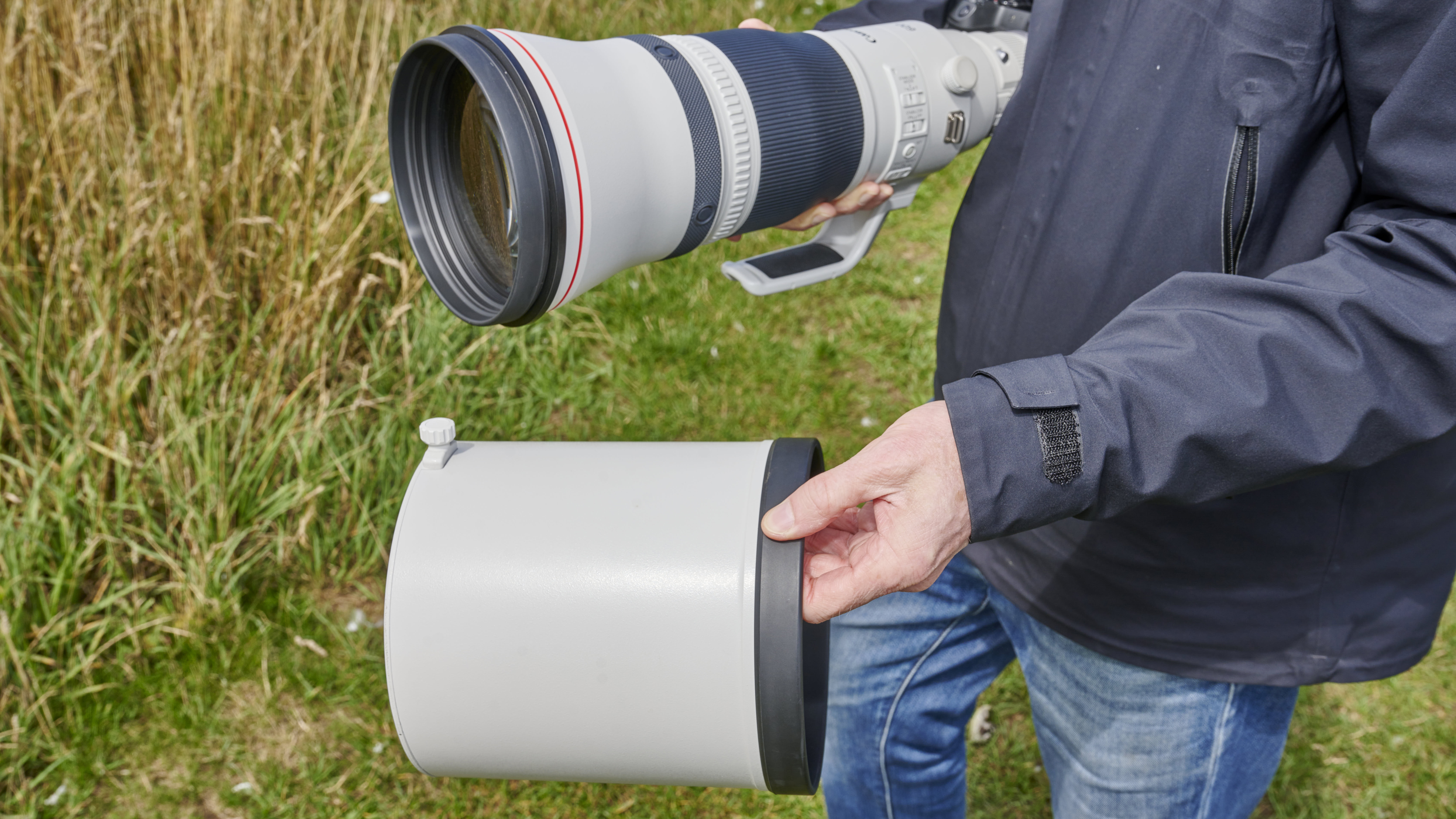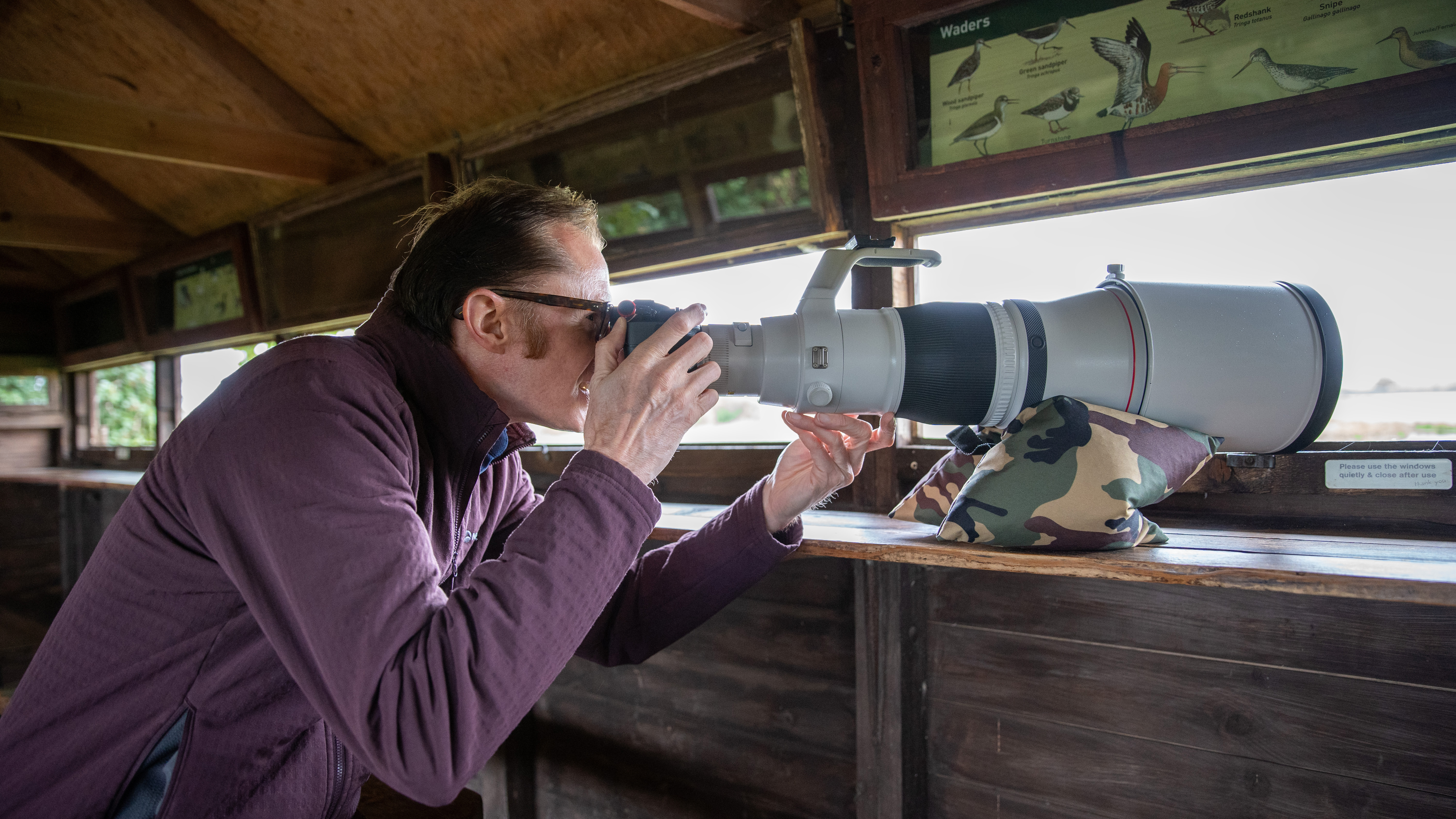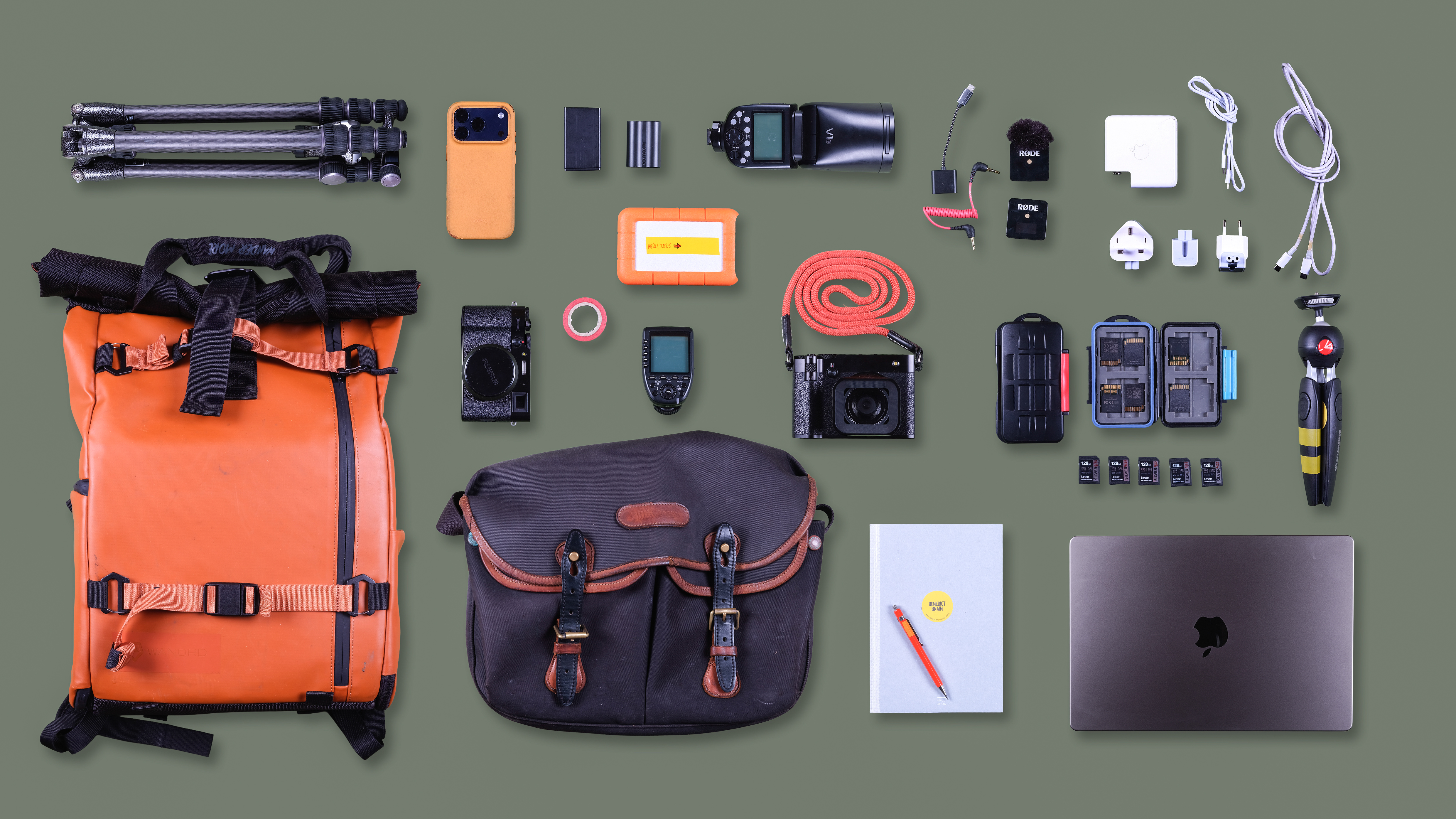Digital Camera World Verdict
The Canon RF 600mm f/4L IS USM is an indispensable optic for professional sports and wildlife photographers who need its combination of reach and bright aperture – but renting one will be more viable for non-pros. Whoever uses this lens can't fail to be impressed by its handling and performance, though. As expected for the price, the high-end optical path renders terrific images, and while I didn’t get to see the best of this lens’s color rendition on a dreary morning spent shooting with it, the autofocus and stabilization systems still delivered consistent results. With such a formidable form factor, though, maintaining a consistent rate of 'keeper' images with this super-telephoto prime will require the user to give their arms regular breaks.
Pros
- +
Impressive image quality
- +
Fast autofocus performance
- +
Excellent stabilisation
- +
Superb build quality
Cons
- -
Imposing size
- -
Regular breaks needed when handholding
- -
Priced beyond most budgets
Why you can trust Digital Camera World
The Canon RF 600mm f/4L IS USM super-telephoto prime announced in April 2021, at a time when Canon rolled out its EOS R3 pro mirrorless plus a brace of new glass for its RF mount.
The RF 600mm was unveiled at the same time as the RF 400mm f/2.8L IS USM. Both lenses are based on their EF counterparts, the EF 400mm f/2.8L IS III USM and the EF 600mm f/4L IS III USM, which were announced at the same time as Canon jumped into full-frame mirrorless with the EOS R in fall 2018.
While the RF versions look virtually the same as their EF forebears, they offer half a stop more of optical stabilization and are the first RF-mount lenses to feature a double power drive mechanism, enabling faster autofocus performance with compatible cameras.
With their heat-resistant white finishes and red L-series rings, both of these constant aperture super-telephotos are designed for sports and wildlife pros who need the combination of long reach, a tight depth of field, and the ability to freeze movement even in low-light conditions, along with the ruggedness and durability that professional users need.
I recently borrowed an RF 600mm f/4L IS USM from Canon for a Digital Camera World magazine shoot at the RSPB Bempton Cliffs nature reserve in England, UK, where I was joined by the leading international wildlife photographer and Canon ambassador Ellie Rothnie, who had offered to mentor one of our readers.
An article about our day at Bempton Cliffs will appear in the October 2025 issue of Digital Camera World magazine.
Canon RF 600mm f/4L IS USM: Specifications
Mount options | Canon RF, RF-S |
Lens construction | 17 elements in 13 groups |
Autofocus | Yes |
Stabilization | Yes |
Diaphragm blades | 9 |
Minimum aperture | f/32 |
Minimum focus distance | 16.5" / 42cm |
Maximum magnification ratio | 0.15x |
Filter size | 52mm (drop-in) |
Dimensions | 18.58 x 6.61" (472 x 168mm) |
Weight | 6.82lbs (3090g) |
Canon RF 600mm f/4L IS USM: Price
On sale since 2021, the Canon RF 600mm f/4L IS USM is currently available for $13,999 / £14,180 / AU$22,799. Its predecessor for Canon DSLRs, the Canon EF 600mm f/4L IS III USM, retails for $13,999 / £14,179 / AU$22,999.
The best camera deals, reviews, product advice, and unmissable photography news, direct to your inbox!
Comparable lenses for other systems include the Nikon Z 600mm f/4 TC VR S, with a built-in 1.4x teleconverter, priced at $14,496 / £13,499 / AU$23,999, and the Sony FE 600mm f/4 GM OSS, which costs $12,998 / £11,999 / AU$21,999.
An alternative option for Sony E-mount users, although not quite as long as the Canon RF 600mm f/4, is the Sigma 500mm f/5.6 DG DN OS Sports (£2,779 / $2,999 / AU$5,695), which is also available for L-mount cameras. The version of this lens for Canon EF and Nikon F DSLRs, the Sigma 500mm f/4 DG OS HSM Sports, costs $5,999 / £4,999 / AU$8,699.
Canon RF 600mm f/4L IS USM: Design & Handling
Weighing in at 6.82lbs (3090g) and measuring 18.58 x 6.61" (472 x 168mm), the RF 600mm f/4L IS USM is a pretty formidable optic.
But appearances can be deceiving. The lens doesn't feel as heavy as it looks, and has been engineered to be well-balanced – the weight of the lens feels well distributed along the barrel. (Canon significantly reduced the weight of the EF 400mm f/2.8L IS III USM and the EF 600mm f/4L IS III USM lenses, as we reported in 2018.)
Supplied in a padded pouch, with an E-185C fabric lens cap to protect the front element, the RF 600mm f/4L has a rubber ring on the end of the lens.
This means it could be placed downwards on the ground, where its 6.61" diameter offers enough of a footprint for the lens to be impervious to a light breeze, but with its substantial price tag, you'd most likely reach for the reassurance of the padded pouch during breaks in shooting.
As mentioned, the external appearance of the RF 600mm f/4L shares a heck of a lot with the EF 600mm f/4L IS III USM. Laid side by side, all that would separate them would be the focus distance scale that has become an in-camera display on EOS R cameras – and a difference in length of 1" (240mm).
That and a longer section at the mount end of the lens, which is almost exactly the depth of the EF-EOS R mount adapter you'd use for porting your EOS DSLR optics to RF mount mirrorless cameras.
Function control switches are arranged in two clusters for operation by the photographer's left hand. Furthest forward are a bank of switches. The top two are for choosing the stabilizer mode (1, 2, or 3: for static subjects/ for panning, horizontally and vertically/ only engaged at the point of capture), and activating or deactivating the image stabilizer.
Underneath that is a switch for selecting the focus preset mode (on, off, or for a beep sounding when focus is achieved at the stored preset point), and above that is a Set button for recording the two preset points you can save.
Ahead of this is a wide and responsive ring for manual focusing, just behind a knurled ring control for jumping focus between preset points – handy for switching to subjects at different distances when refocusing would cost valuable seconds – and for executing focus pulls while filming video.
Four lens function buttons (programmable by the user) sit within a narrow black band, at 90º points around the barrel. So, however the lens is rotated, one will fall under the fingers.
Farther back, close to the lens mount, are the AF system controls: a switch for enabling or disabling AF, Power focus or Manual focus modes, and below that is a focus limiter switch offering three positions – Full, 4.2m-16m, 16m-infinity – to stop the lens hunting for focus outside the latter two distance ranges.
Another feature carried over from the EF 600mm f/4L IS III USM is the slot for drop-in filters, just in front of the lens mount. The RF600mm f/4L comes with a 52mm protection filter, although Canon also makes a circular polarizing filter and offers a compatible holder for inserting gelatin filters.
A sturdy tripod mount offers ¼" and ⅜" threads and is padded on the inside so it can be used as a carrying handle. Sturdy lugs on the barrel allow a strap to be attached for letting your shoulders take the load when transporting the lens.
The tripod collar rotates through 360º when the locking knob is loosened, and there's a satisfying click when it reaches each 90º point.
If 600mm of reach isn't enough, or 960mm on an EOS R-series camera with an APS-C sensor, then the RF 600mm f/4L is compatible with Canon's RF 1.4x and RF 2x teleconverters, producing 840mm and 1200mm, respectively.
Autofocus and image stabilization will still operate, but at the expense of narrower apertures: f/5.6 to a minimum aperture of f/45 when used with the 1.4x Extender, and f/8-f/64 for the 1.4x Extender.
Talking of apertures, the RF 600mm f/4L has nine diaphragm blades for producing the dreamy defocused areas we relish with telephoto lenses.
Canon RF 600mm F4L IS USM: Performance

Bempton Cliffs is one of the foremost locations for photographing seabirds in the UK and is operated by the RSPB (Royal Society for the Protection of Birds).
Puffins, gannets, guillemots, and kittiwakes are among the half-million seabirds that congregate here in the summer months, earning Bempton Cliffs its 'seabird city' tag.
On the day I visited, light rain was falling and was forecast to continue for a couple of hours.
We were joined by Digital Camera World reader Owen Eaton, an experienced wildlife photographer and conservationist, whose typical setup is a Canon EOS 5D Mark IV and EF 300mm f/2.8L IS ISM lens.
Positioning ourselves at Bartlett Nab, we started photographing the flurry of diving gannets. They were moving too quickly and erratically to be photographed by a camera on a support, so the next few hours were going to be a test of hand-held shooting skills.
The RF 600mm f/4L was mounted on a Canon EOS R, which was set to Servo AF with face and tracking autofocus enabled, and the drive mode set to high-speed continuous.
Overcast and drizzling, the light levels were pretty gloomy, but the RF 600mm f/4L's autofocus coped well, acquiring and tracking plenty of gannets as they flew, swooped, and landed.
While the RF 600mm f/4L has a dual-powered ultrasonic focusing drive, the EOS R doesn't support this functionality, but the AF performed snappily, and while it did register a tiny bit of noise, it wouldn't have been off-putting for our feathered friends. And even if you were photographing larger animals on a safari, you'll be a fair distance away from them.
Shooting predominantly white birds with black, grey, and pale yellow markings against backgrounds of white clouds or a gunmetal sea, today's color palette was muted. A sporting event with colorful kit and adverts would be a better test of the lens's color rendition and Canon's famed color science, but there was plenty of information in our raw files for editing afterwards.
Pro grade so fully weather-sealed as you'd expect at this price point, and with the lens hood attached to keep the rain at bay, we weren't overly concerned about what the brooding skies over Britain's North Sea could soon be throwing at the RF 600mm f/4L. The lens's weather-sealing includes fluorine coatings on the front and rear elements.
Inside the barrel, fluorite and Super UD glass elements are employed to produce extra sharpness and control distortion, while ASC (air-sphere) and SSC (super-spectra) coatings have been applied to keep distortion and flare to a minimum, even when the lens is used wide-open at f/4.
Optical stabilization on the RF 600mm f/4L IS USM is half a stop better than that of the EF600mm f/4L IS III USM, to a maximum of 5.5 stops. (EOS R-series cameras with in-body image stabilization, including the EOS R1, R3, R5, R5 Mark II, R6, R6 Mark II, and R7, can work in tandem to push this a couple of stops higher.)
As Canon's first full-frame mirrorless, the EOS R has no in-body image stabilization (although it debuted a dual-sensing IS system, which compares data from a sensor in the lens with camera sensor movement, to boost the efficacy of the optical IS). So the onus fell on the RF 600mm f/4L IS USM to do the heavy lifting and help capture shake-free frames. And it looks to have done this with aplomb…
Canon RF 600mm f/4L IS USM: Sample images
Here's a selection of photos captured by Digital Camera World reader Owen Eaton Owen (@wild_sights_) at Bempton Cliffs in July 2025. Weather conditions were overcast with gusty winds, but it was a great day for getting close to seabirds – especially gannets.
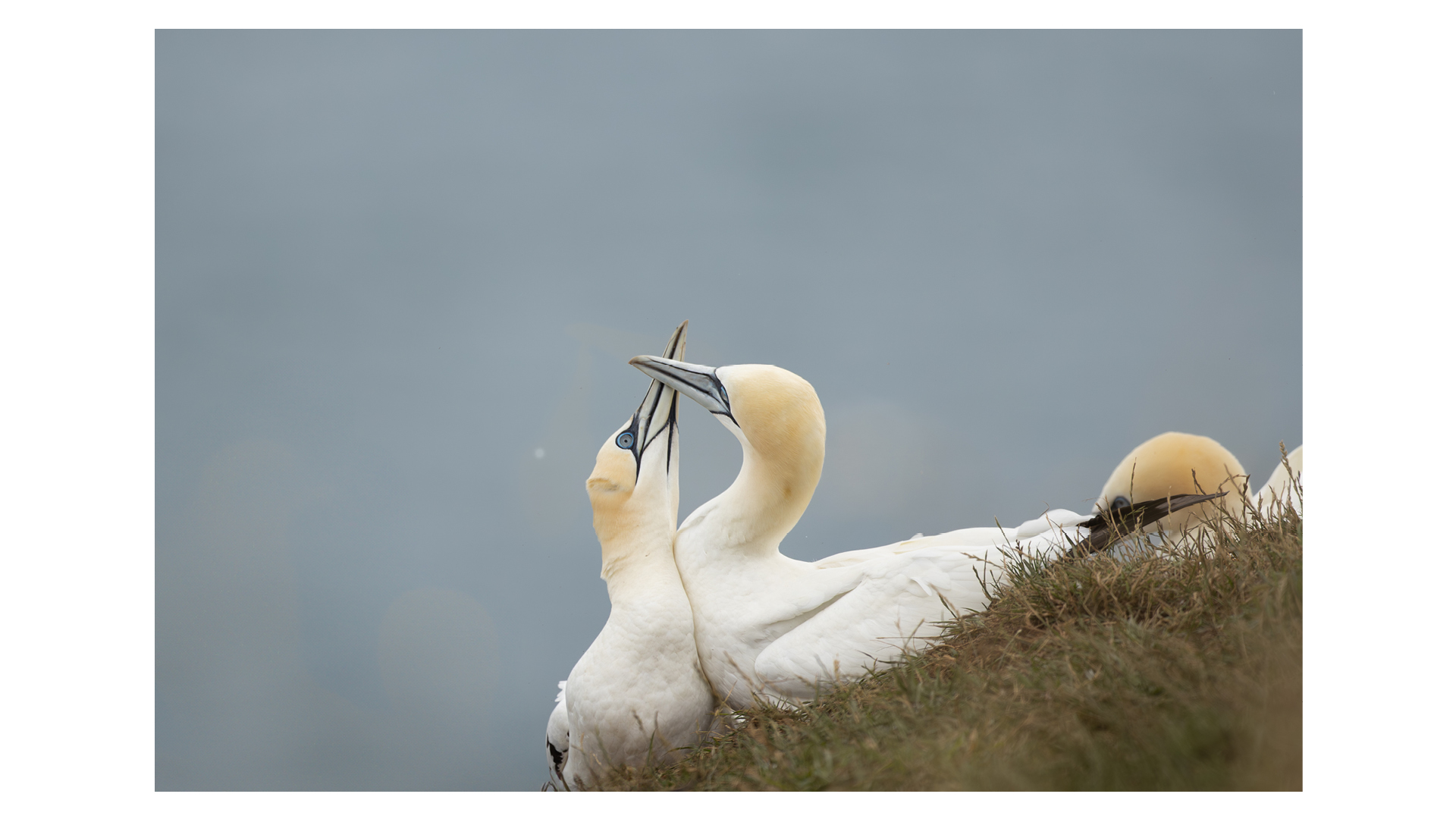
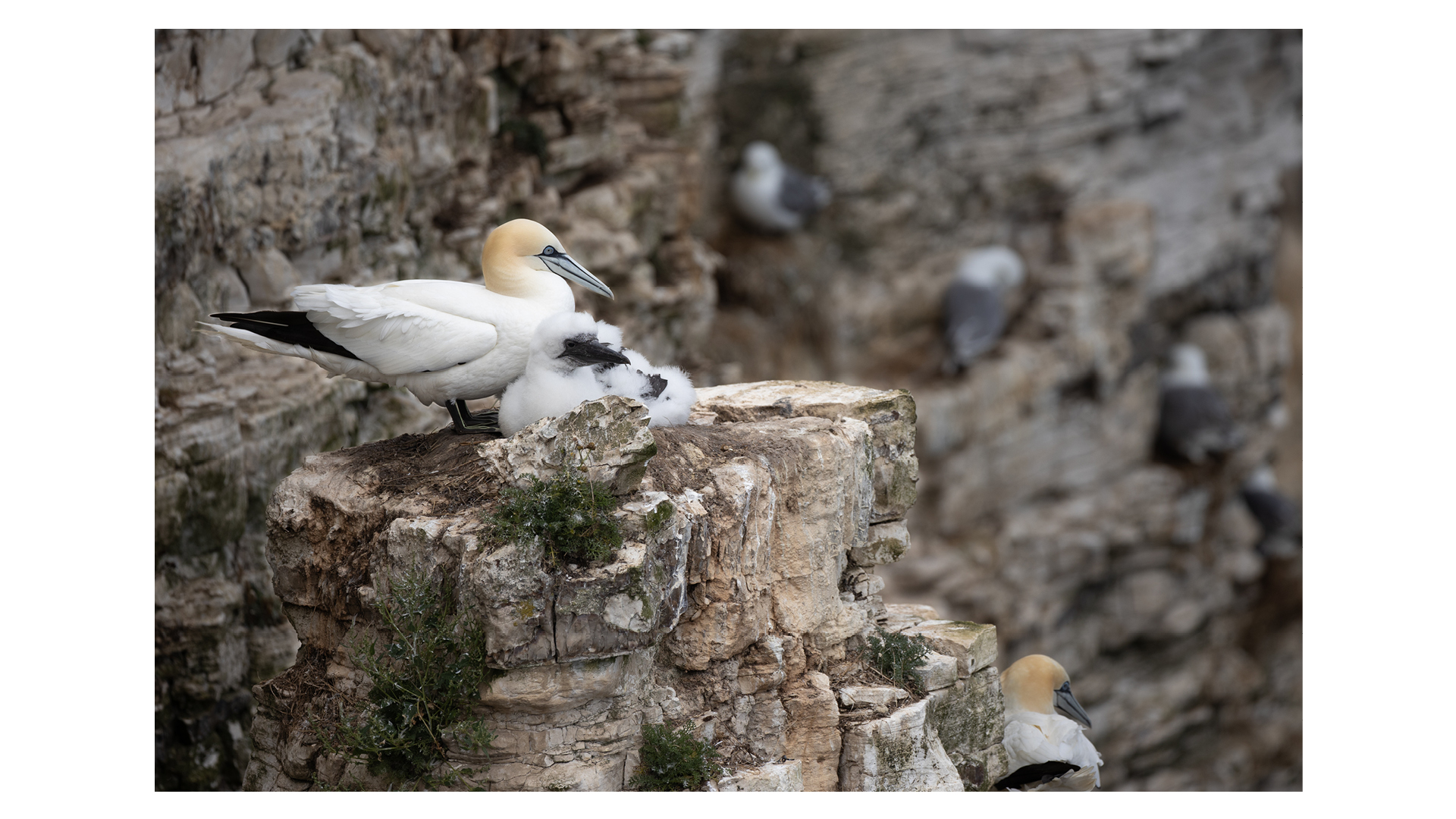
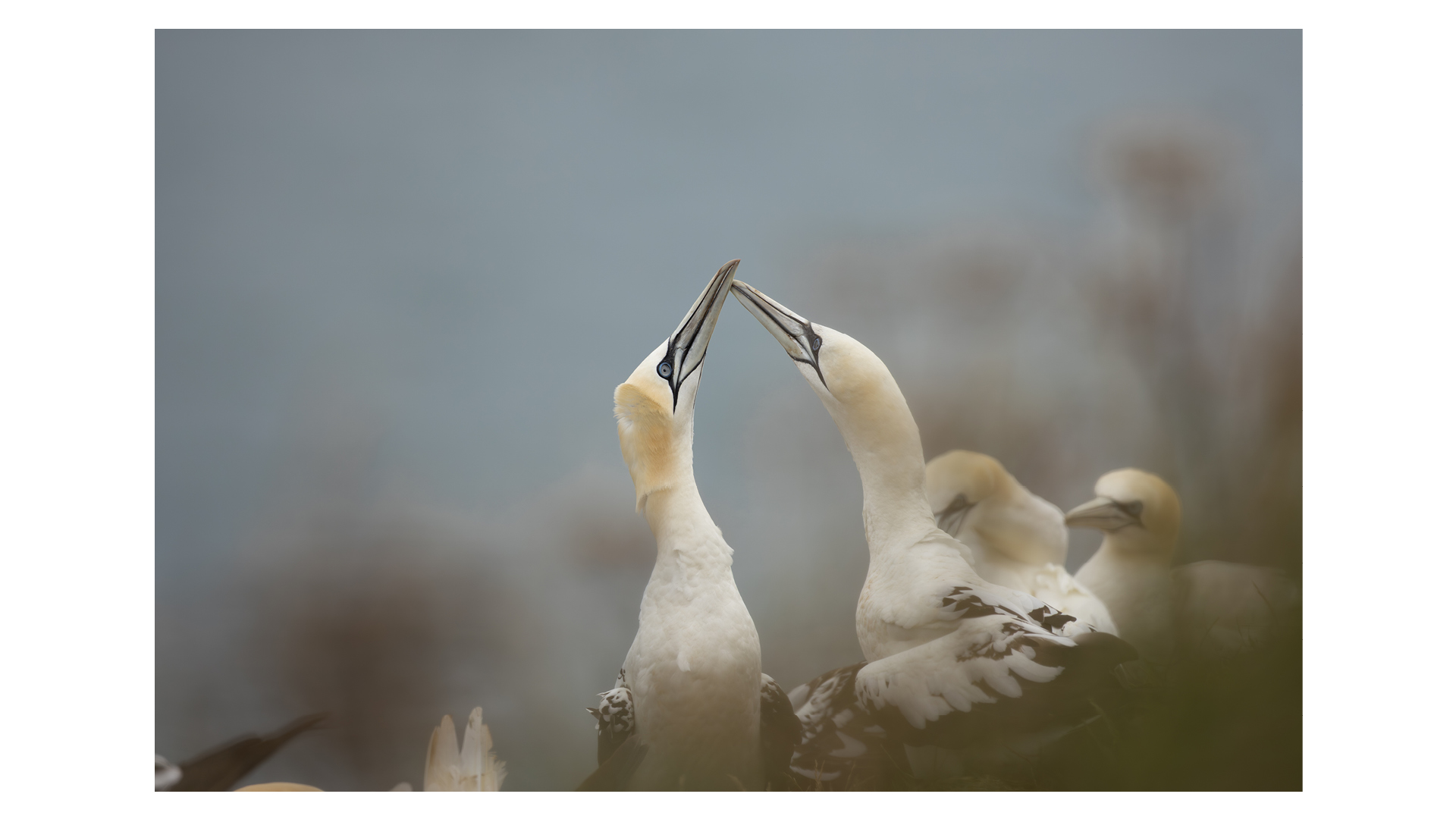

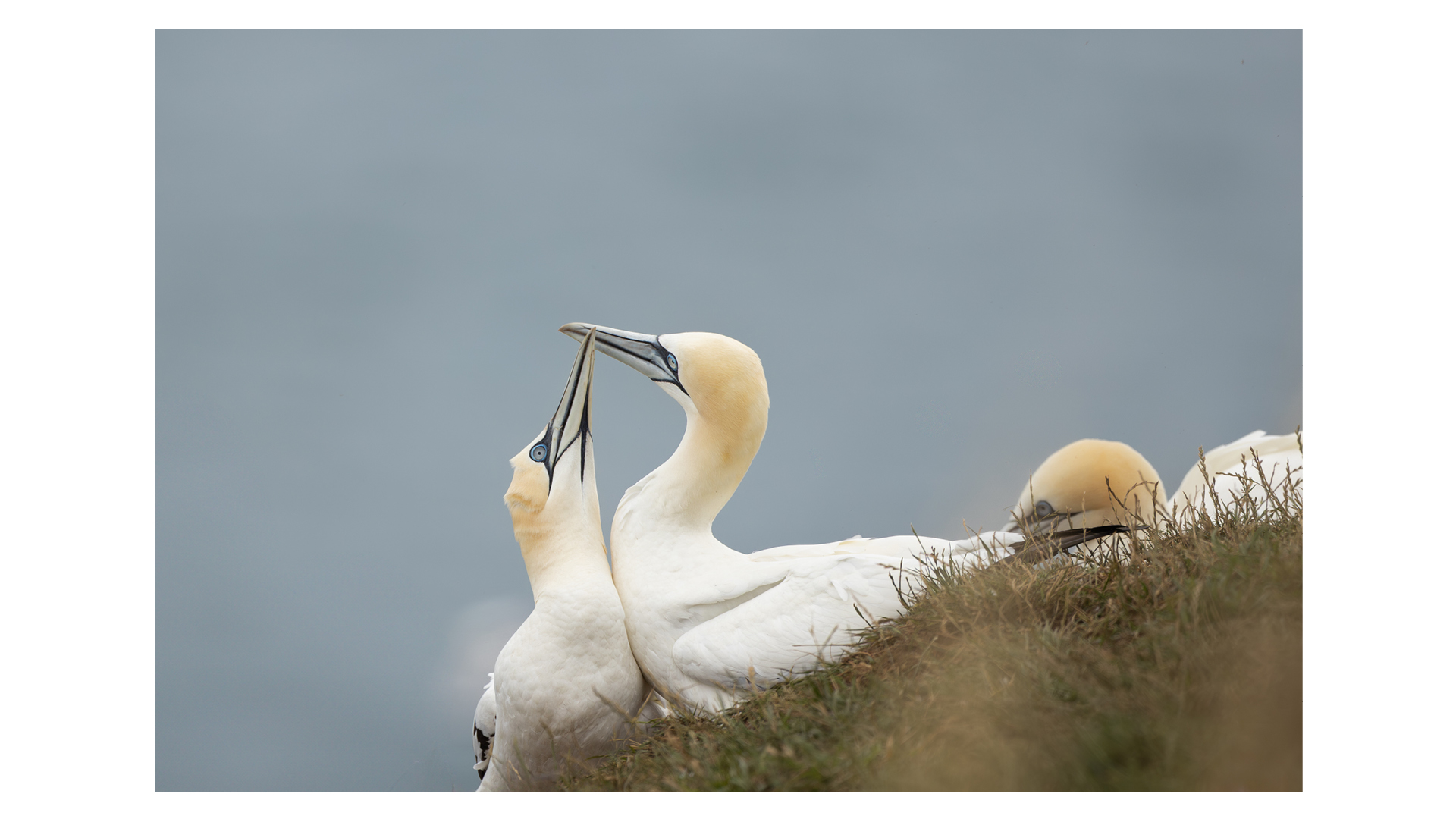
So what did this experienced wildlife photographer make of his time using the Canon RF 600mm f/4L IS USM?
"I was seriously impressed with the overall performance and feel of the lens," he said. "The autofocus was snappy and held the gannets well as they moved about in the frame, which was impressive as there was lots of sudden and unpredictable movement owing to the wind.
"I found it to be much lighter than I was expecting. Given that with the lens hood on, it's easily over a meter long, it was noticeably lighter than my older Canon EF 300mm f/2.8 IS ISM lens. The EF 300mm is at least half the size of the RF 600mm, so this was something I didn't expect, and it was definitely a welcome surprise.
"Looking through the images I took, the RF 600mm F4 has great detail retention when cropping in, and that editing approach worked well for the picture of the parent and chick on the cliffside.
"My only concern with the lens is that with its large diameter, it has to have quite a large lens hood. In the high winds, I was being dragged off target as the hood caught gusts of wind, which is something I've never experienced before.
"On a dry and windy day, you could just remove the hood so there would be no problem, but when it’s wet and windy, or if you’re working in a dusty or sandy environment, I would imagine it would be quite a struggle and would require some creative stabilisation to make it work.
"But this is a very minor concern in the grand scheme of things. The RF 600mm f/4 IS USM was a pleasure to use and is a dream piece of kit for any wildlife photographer."
Canon RF 600mm f/4L IS USM: Lab results
We run a range of lab tests under controlled conditions, using the Imatest Master testing suite. Photos of test charts are taken across the range of apertures and zooms (where available), then analyzed for sharpness, distortion and chromatic aberrations.
We use Imatest SFR (spatial frequency response) charts and analysis software to plot lens resolution at the center of the image frame, corners and mid-point distances, across the range of aperture settings and, with zoom lenses, at four different focal lengths. The tests also measure distortion and color fringing (chromatic aberration).
Sharpness:
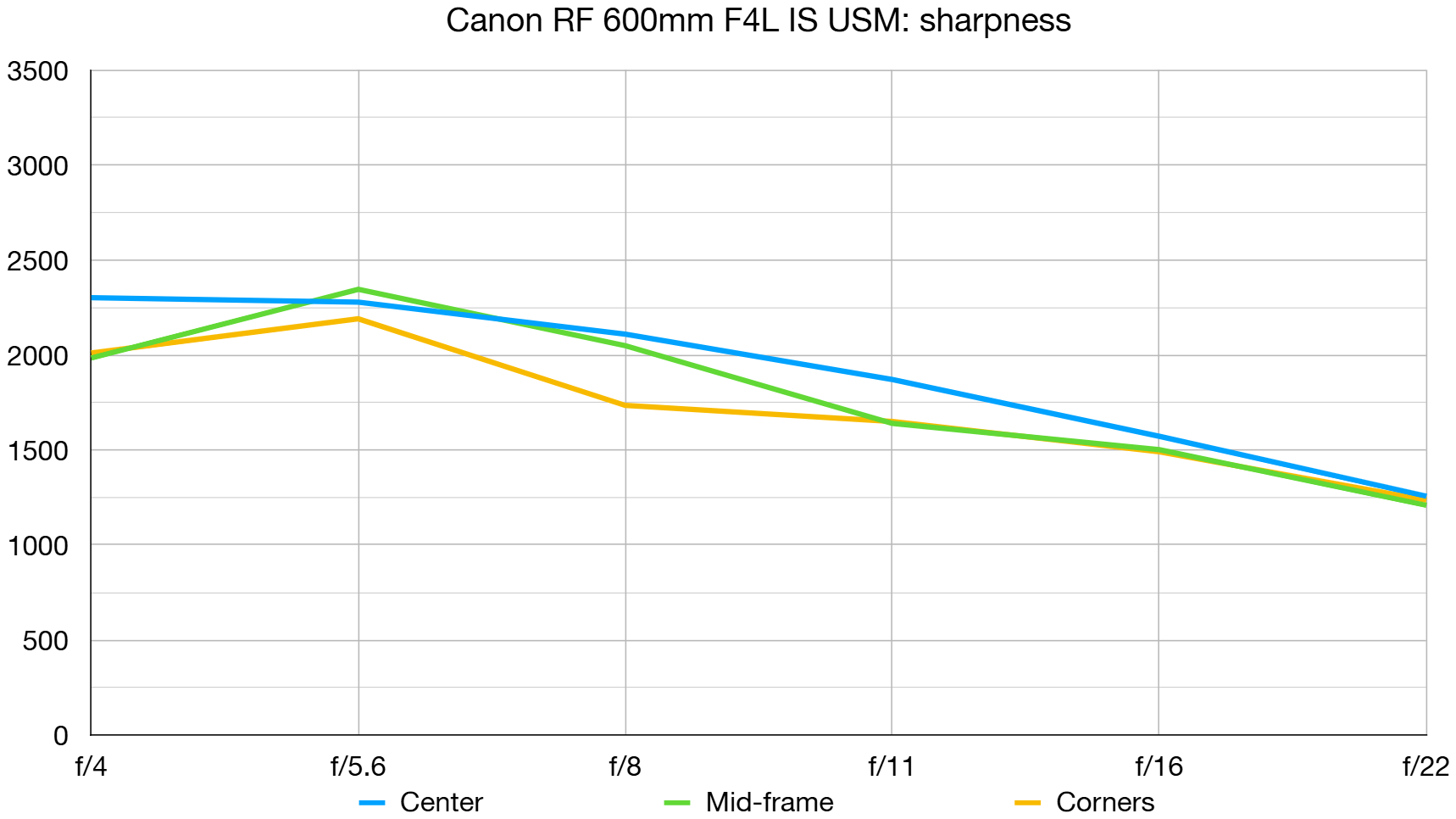
Sharpness is very good, from wide open through to f/11. Most impressive is how consistently sharp the lens is across the entire image frame.
Fringing:
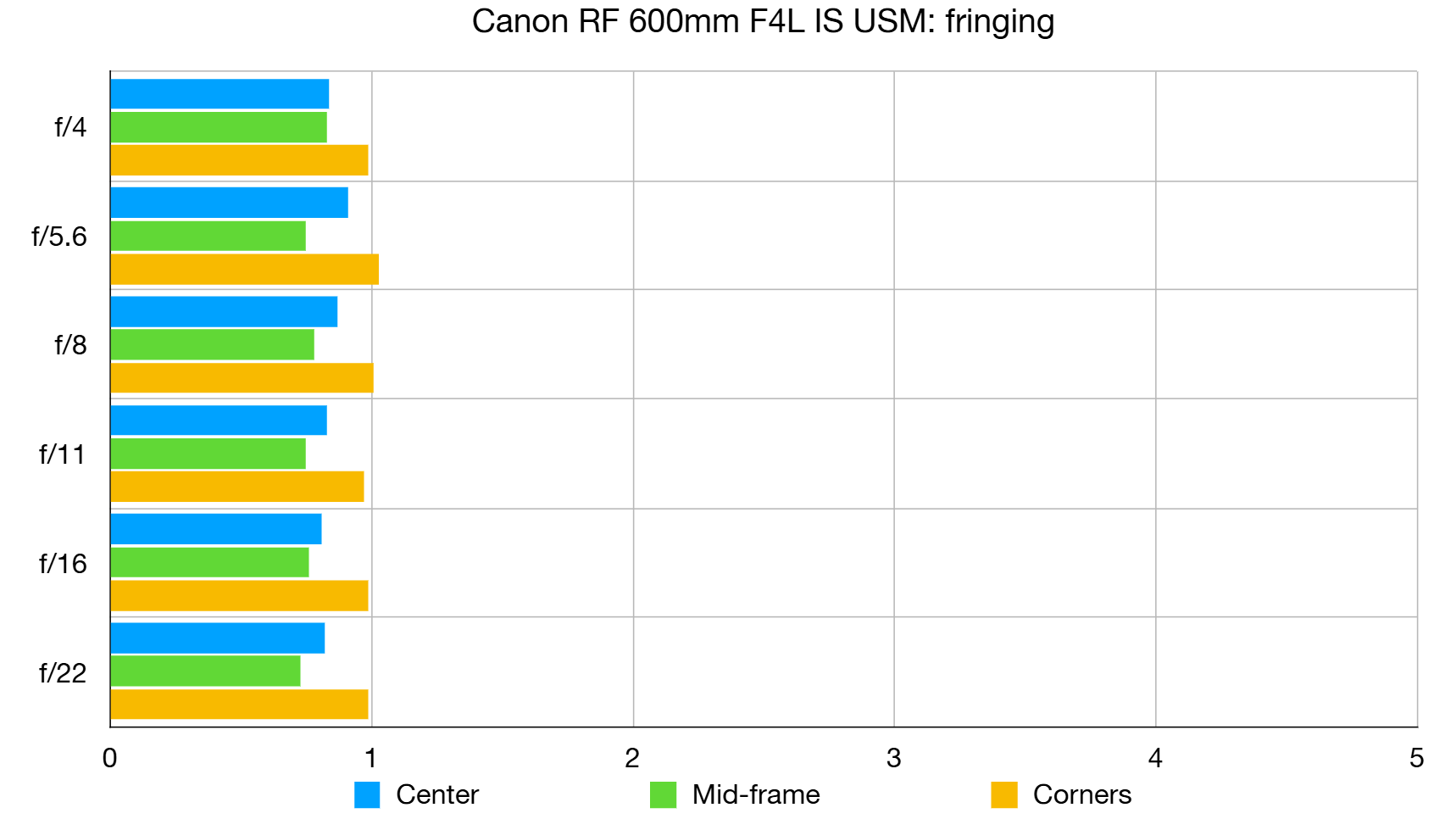
Fringing isn't quite as low as it could be, but it's consistently below the level of being noticeable in real-world shooting, and that's all that really matters.
Distortion: 0.01
We wouldn't expect much distortion from such a high-end lens with this focal length, and the RF 600mm f/4L doesn't disappoint, producing a near-perfect score.
Canon RF 600mm f/4L IS USM: Verdict
Priced at $13,999 / £14,180 / AU$22,799, it's clear the RF 600mm f/4L IS USM isn't going to be a volume seller for Canon. It's obviously an indispensable tool for professional sports and wildlife photographers who need its combination of reach and bright aperture – for the rest of us, renting one by the day for a couple of hundred dollars or pounds would be a more sensible option.
All users of this lens won't fail to be impressed by its handling characteristics and performance, though. If you can handle a super-telephoto well and take the time to set up both lens and camera correctly for what you're shooting, then the RF 600mm f/4L will produce impressively sharp images when unsupported.
As expected for the price, the high-end optical path captures pleasing images with that signature long lens focus fall-off in front of and behind subjects when used wide-open.
We didn't see the best of this lens's color rendition on our dreary morning spent shooting with it, but the autofocus and stabilization systems both delivered consistently.
The form factor of the RF 600mm f/4L IS USM super-telephoto is formidable, though, so to maintain a decent hit rate of 'keeper' images, your arms will benefit from having regular breaks. But with your body, lens, and camera in sync, then you'll bag sports and wildlife shots worthy of a pro.
Features ★★★★★ | Bright aperture, cutting-edge autofocus and stabilization, fully weather-sealed and built to cope with the rigors of fast-paced sports and wildlife photography. |
Design and handling ★★★★☆ | Formidable size, but feels lighter in the hand than it looks. Barrel controls follow the established configuration of Canon telephotos, every switch and button placement feels intuitive. |
Performance ★★★★☆ | Superb results when used handheld to capture fast and erratically moving birds. Stabilization is very effective at countering the micro-movements that are unavoidable when toting such a big optic. |
Value ★★★★☆ | Seriously expensive so will be an investment limited to those with very deep pockets. For everyone else, renting the RF600mm F4L by the day will be a more viable option. |

Niall is the editor of Digital Camera Magazine, and has been shooting on interchangeable lens cameras for over 20 years, and on various point-and-shoot models for years before that.
Working alongside professional photographers for many years as a jobbing journalist gave Niall the curiosity to also start working on the other side of the lens. These days his favored shooting subjects include wildlife, travel and street photography, and he also enjoys dabbling with studio still life.
On the site you will see him writing photographer profiles, asking questions for Q&As and interviews, reporting on the latest and most noteworthy photography competitions, and sharing his knowledge on website building.
You must confirm your public display name before commenting
Please logout and then login again, you will then be prompted to enter your display name.
